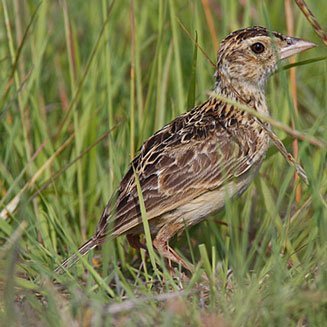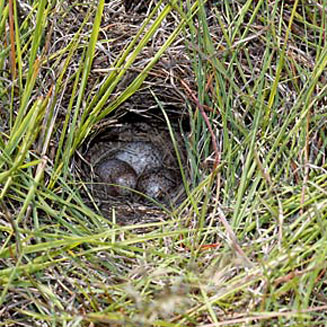|
Heteromirafra ruddi (Rudd's
lark)
[= Mirafra ruddi]
Drakensberglewerik [Afrikaans]; Sporenleeuwerik [Dutch];
Alouette de Rudd [French]; Spornlerche [German]; Cotovia de Rudd
[Portuguese]
Life
> Eukaryotes >
Opisthokonta
> Metazoa (animals) >
Bilateria >
Deuterostomia > Chordata >
Craniata > Vertebrata (vertebrates) > Gnathostomata (jawed
vertebrates) > Teleostomi (teleost fish) > Osteichthyes (bony fish) > Class:
Sarcopterygii (lobe-finned
fish) > Stegocephalia (terrestrial
vertebrates) > Tetrapoda
(four-legged vertebrates) > Reptiliomorpha > Amniota >
Reptilia (reptiles) >
Romeriida > Diapsida > Archosauromorpha > Archosauria >
Dinosauria
(dinosaurs) > Saurischia > Theropoda (bipedal predatory dinosaurs) >
Coelurosauria > Maniraptora > Aves
(birds) > Order: Passeriformes
> Family: Alaudidae
 |
|
|
Rudd's lark, Wakkerstroom district, Mpumalanga,
South Africa. [photo Warwick Tarboton ©] |
|
Distribution and habitat
Endemic to South Africa, only occurring in localised
populations in Mpumalanga (especially Wakkerstroom), KwaZulu-Natal and the
extreme east of the Eastern Cape. It is extremely habitat specific, preferring
Highveld sourveld and North-eastern sandy highveld, on flat areas with dense,
short grass. It is absent from old croplands, grassland on slopes and patches
where the grass is more then 70cm tall.
|
 |
|
Distribution of Rudd's lark in southern Africa,
based on statistical smoothing of the records from first SA Bird Atlas
Project (©
Animal Demography unit, University of
Cape Town; smoothing by Birgit Erni and Francesca Little). Colours range
from dark blue (most common) through to yellow (least common).
See here for the latest distribution
from the SABAP2. |
Food
It mainly eats insects supplemented with seeds, doing most
of its foraging alone, gleaning food from the bases of and leaves of grass tufts. The following food items have been recorded
in its diet:
Breeding
- The nest (see image below) is a domed structure with a side entrance,
which is either a simple hole or a short, spout-like tunnel. It is typically
built with dry grass, placed in a scrape in the ground at the base of a
grass tuft, the leaves of which are often integrated into the nest.
 |
|
|
Rudd's lark nest with eggs, Wakkerstroom area,
South Africa. [photo Warwick Tarboton ©] |
|
- Egg-laying season is from October-February, peaking from
November-February.
- It lays 2-4 eggs, which are incubated solely by the female for about
13-15 days.
- Initially the chicks are mainly brooded by the female, while the male
forages for himself, her and the young. Later, they both equally contribute
food to the chicks, who eventually leave the nest at about 11-15 days old,
before they can fly.
Threats
Critically endangered, due its extremely fragmented
distribution and small population, which is estimated to be less than 5000
individuals and decreasing. Its situation is mainly due to the fact that its
favoured habitat (grassland) is one of the least protected biomes in South
Africa, as it is seriously degraded and destroyed for afforestation and
agriculture. It is most common in the Wakkerstroom region in Mpumalanga, so it
has been proposed that it would wise to set up a Grassland Biosphere Reserve
centered on this area.
References
-
Hockey PAR, Dean WRJ and Ryan PG 2005. Roberts
- Birds of southern Africa, VIIth ed. The Trustees of the John Voelcker
Bird Book Fund, Cape Town.
|
